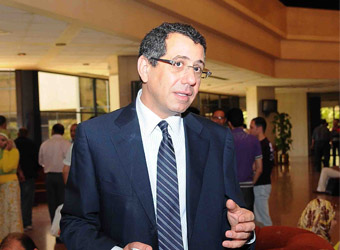Beltone Financial (BTFH.CA), stated, in a recent research that, domestic liquidity in August 2012 improved on the aggregate level, where M2 annual growth picked up to 8.9% in August 2012, from 8.1% a month earlier. On a monthly basis, M2 growth also picked up to 1.2% in August 2012, from 0.7% a month earlier.
The improvement in M2 growth was led by a pick-up in its largest component, the LCY time and savings deposits, which grew 9.5% y-o-y and 0.6% m-o-m in August 2012, compared to 8.9% y-o-y and 0.2% m-o-m, a month earlier. M2 growth was reflected in a slowdown in net foreign asset (NFA) contraction and the steady performance of net domestic assets (NDA).
However, some factors behind the improvement in domestic liquidity signal some weaknesses in confidence levels. A significant pick-up in FCY deposit growth was witnessed in August 2012 on both a monthly and annual bases, reaching 0.65% m-o-m and 6.2% y-o-y, up from 0.2% m-o-m and 3.9% y-o-y a month earlier. Currency in circulation outside the banking system also witnessed accelerated monthly growth of 3.7% in August 2012, up from 1.2% m-o-m a month earlier. LCY demand deposits contracted by 0.7% y-o-y and 1% m-o-m. We believe that weak NIR data released end of July 2012 could have triggered a drop in confidence levels during August 2012.
Total deposit growth accelerated to 7.8% y-o-y in August 2012, up from 6.8% y-o-y a month earlier, as a result of the increase in LCY and FCY deposit growth. Growth in household LCY deposits, the largest component of LCY deposits, reached its highest since February 2011 at 14% y-o-y in August 2012, up from 13% y-o-y a month earlier.
Public and private business sector LCY deposits continued to contract on an annual basis by 21% and 12%, respectively, in August 2012, signaling a yet weak performance of the business sector and weak confidence levels. Growth in household FCY deposits, the major component of FCY deposits, accelerated to 5.8% y-o-y in August 2012, up from 4.2% y-o-y a month earlier.
Growth in public and private business FCY deposits continued to increase in August 2012 to reach 14% y-o-y and 6% y-o-y, respectively, as hedging continues against a depreciation in the domestic currency. Private business sector and the household sector FCY deposits have also been on the rise since the January 25th revolution, growing by an average of 13% and 12%, respectively. However the dollarization rate (FCY deposits/M2) remained relatively stable at 16.8% in August 2012.
Domestic credit growth remained stable in August 2012 at 20.6% y-o-y, on the back of continued bank financing of government debt. Net claims on the government continued to grow by 36.4% y-o-y in August 2012, slowing down from the peaks of an average of 45% growth witnessed during September 2011 to January 2012, on favorable base effects.
Bank claims on the private sector continued to grow steadily by 4.9% y-o-y in August 2012, but still not reaching pre-revolution levels, although growth should have reflected favorable base effects. We believe the crowding-out effect continues to be limited, as expansionary plans are still on hold and demand for credit is still relatively weak.
Total net foreign assets (NFAs) of the banking system continued to plummet, and contracted by a significant 37% y-o-y in August 2012 and 1.5% m-o-m. The contraction in total NFAs in August 2012, comes on the back of a contraction in commercial bank NFAs, which dropped by 21% y-o-y and 4.2% m-o-m. While the central bank’s NFAs increased by 2% m-o-m in August 2012, its value is 48.5% below what it was a year ago.
Annual headline inflation continues to drop, on the back of slowing domestic activity during the past year, with headline inflation dropping to 6.2% y-o-y in September 2012 from 6.4% y-o-y a month earlier, also benefiting from favorable base effects.
Annual inflation in clothing and footwear, housing, furniture and equipment, and recreation and culture all fell sharply in September 2012, reflecting the general weakened domestic activity. However, annual food price inflation accelerated in September 2012, in line with higher global food prices. On a monthly basis, annual inflation picked up slightly in September 2012, as the school year began. It seems the impact from a reduction in Egypt’s grain imports is reflecting positively on monthly food price inflation, where food price increases subsided on a monthly basis in September 2012, falling to 1.8% m-o-m from 2.5% m-o-m in August 2012. While we expect monthly inflation in October 2012 to remain steady at c.1% m-o-m, annual inflation will pick up to 6.9% on unfavorable base effects.
Inflation should start picking up again steadily until year-end as funds start flowing into Egypt and consumer confidence picks up. External currency pressures persist, with balance of payment fundamentals remaining weak. Since we expect inflation to start picking up again steadily until year-end as funds start flowing into Egypt and consumer confidence picks up, and since the demand for credit has not yet recovered and pressures on the EGP persist, we believe that, at this juncture, the current interest rate policy remains suitable.
We expect key policy rates to remain unchanged in today’s MPC meeting and until year-end. We expect the CBE to keep the overnight deposit rate and overnight lending rate unchanged at 9.25% 10.25%, respectively, and the 7-day repo at 9.75%. In addition, we expect the CBE to keep its discount rate unchanged at 9.5%. Our anticipation of unchanged policy rates is attributable to our expectations of manageable inflation rates, slowly recovering economic activity, and continued currency pressures until year-end.



